To facilitate learning several specific materials are designed to be used within the active learning environment.
Some of this equipment includes:
Activity Boards
Brush Board: The brush board encourages tactile exploration particularly with the hands. It can also facilitate banging games, separating games when brushes are joined together and transfer of objects between hands.
Tactile Board: This is made to encourage children to bend and scratch with their fingers. Pieces of materials of various textures are glued to the board. Examples of suitable materials are artificial grass, bubble plastic and corrugated cardboard.
The Position Board: A piece of pegboard approximately 30 x 45cm's on to which various  objects have been tied by elastic. The child can manipulate and explore the objects, bringing them to the mouth or moving them from hand to hand. However, if thrown the objects will remain tied to the board to help students repeatedly explore the same object. As many of our students cannot see or move effectively to recover the items as sighted child would do, the elastic is a vital part of the position board. Position boards can take many different forms for many different uses.
objects have been tied by elastic. The child can manipulate and explore the objects, bringing them to the mouth or moving them from hand to hand. However, if thrown the objects will remain tied to the board to help students repeatedly explore the same object. As many of our students cannot see or move effectively to recover the items as sighted child would do, the elastic is a vital part of the position board. Position boards can take many different forms for many different uses.
Activity Vest
The activity vest is a fabric band, apron, shirt or vest which can fit around a child's chest, onto which different materials have been attached. 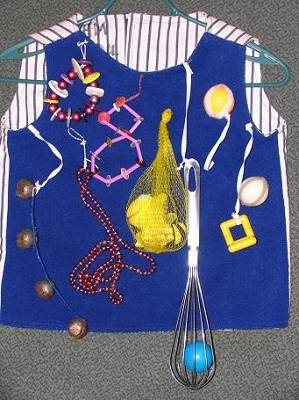
Pockets can also be sewn into the vest to place objects. This encourages exploration by the child who usually holds their hands against the chest. The vest also encourages midline organisation of hands and play, using fingers. The activity vest ensures the child has objects to interact with whenever they choose. The child can make a choice to which objects they play with on the vest and can play independently without adult assistance.
Ball Forest and Den
Ball Forest: The ball forest is a large piece of equipment (dimensions 150cm by 150cm), 
designed to encourage students to explore a large number of objects. The ball forest is made by placing a resonance board (a large piece of plywood with raised edges) on top of four essef boards, offering a less stable surface for students to lay or sit on. Objects are suspended over the area of the resonance board. Because the resonance board is raised off the ground, students also love exploring "vertical space" on the ball forest, by reaching down from the platform with their hands and feet. The ball forest has also been successful in encouraging children to turn to the side or roll and experiment with whole body movements.
Den: The Den is similar to the ball forest but without the essef boards. The den has a stable base and walls, as well as a roof to provide a safe secure boarded environment to work in and explore.
Echo Bucket
The Echo Bucket is a metal bucket that has a chain attached so that it can 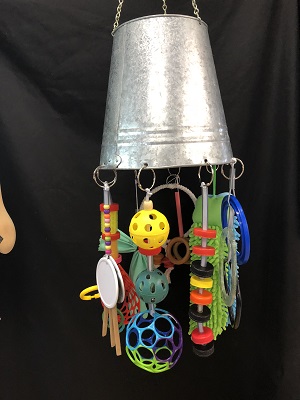 be suspended upside down from a strong support by teachers. Holes have been made around the rim and objects are tied with elastic. The child with low vision lies on a resonance board within the bucket. This, in turn, will encourage the child to make more sounds.
be suspended upside down from a strong support by teachers. Holes have been made around the rim and objects are tied with elastic. The child with low vision lies on a resonance board within the bucket. This, in turn, will encourage the child to make more sounds.
Essef board
The essef comprises two pieces of plywood joined together by six springs. 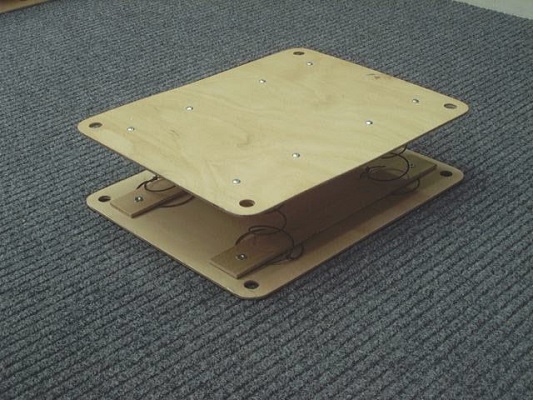 The purpose of the essef is to provide a bouncy platform on which to play kicking and pushing games. The essef may be used in a number of ways: the child can kick against an essef placed beneath their feet; can be used in conjunction with the hopsadress or the Lili hammock; can be used with various tactile or auditory materials placed on the top of it; placed under the feet whilst the child is exploring objects at a table; sit on the essef and the unstable seat can help improve balance.
The purpose of the essef is to provide a bouncy platform on which to play kicking and pushing games. The essef may be used in a number of ways: the child can kick against an essef placed beneath their feet; can be used in conjunction with the hopsadress or the Lili hammock; can be used with various tactile or auditory materials placed on the top of it; placed under the feet whilst the child is exploring objects at a table; sit on the essef and the unstable seat can help improve balance.
Hopsadress
The aim of the Hopsadress is to encourage movement and coordinate movements of the legs and feet. 
The Hopsadress allows exploration with the feet without weight bearing and experience sensory stimuli with correctly placed objects. The benefits of the Hopsadress include: aiding blood circulation and muscle strength; motivating to take steps and explore weight shift in the upright position; coordinate leg with arm and hand movements.
Lili Hammock
The hammock provides another environment at Narbethong for the 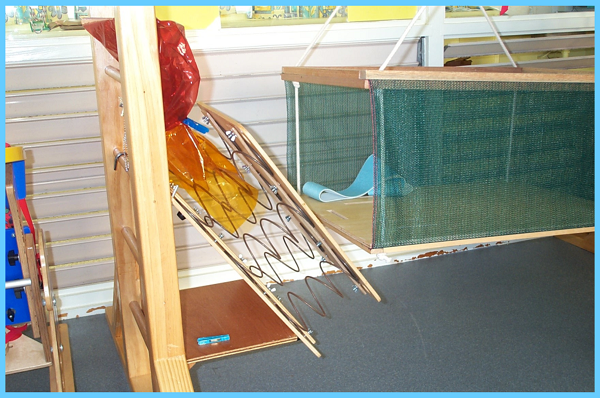 pushing exercises that promote leg and foot movement and awareness that is a pre-requisite for walking. The child is placed in the hammock allowing their feet to come in contact with an essef board. Once the child has learned to push they will experience great satisfaction from continuing the action.
pushing exercises that promote leg and foot movement and awareness that is a pre-requisite for walking. The child is placed in the hammock allowing their feet to come in contact with an essef board. Once the child has learned to push they will experience great satisfaction from continuing the action.
Lilli's Multifunctional Activity Table
The Multifunctional Activity (MFA) Table is designed for the learner to initiate a large variety of cognitive activities. 
The MFA table is designed in such a way that the table top can be set at various heights to accommodate the learner and it provides for a great variety of arrangements as learning environments. Regular activities while using the MFA table: improves the learner's creative capabilities; enlarges their object concept; enhancing their knowledge about which objects can be separated, piles and put together; gives opportunity to become familiar with different kinds of material; facilitates the learning of play constructively; enhances the ability to solve problems. When the MFA table is equipped according the learner's developmental level it will promote the learner's motivation for comparing objects and the results of their activities, memory and the ability to solve problems.
Little Room
It is important to offer students with a visual impairment surrounds that can motivate them to reach for objects as early as possible.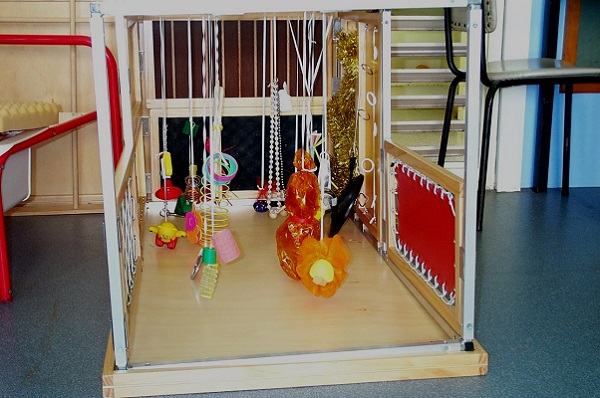 The Little Room is designed to give the child the opportunity to learn about space and to reach for objects. Within the Little Room learners can experience themselves as active people who decide for themselves when and with what they wish to be active. Various activities performed within the Little Room promote the development of: spatial awareness; sensory integration; early object concept; knowledge about the position of objects; and understanding of oneself as the person who produces emerging sounds.
The Little Room is designed to give the child the opportunity to learn about space and to reach for objects. Within the Little Room learners can experience themselves as active people who decide for themselves when and with what they wish to be active. Various activities performed within the Little Room promote the development of: spatial awareness; sensory integration; early object concept; knowledge about the position of objects; and understanding of oneself as the person who produces emerging sounds.
If you would like more information about the little room, please view our "Spatial Awareness" vodcast.
Support Bench
The support bench has been designed to help children with vision impairment and/or
additional disabilities play in a prone position. It facilitates gross motor and fine motor development in many ways. When students are actively atplay using the support bench, this activity strengthens muscles and develops coordination between arm and leg movement and the muscles needed for sitting, crawling and reading. This activity will also help develop the necessary curves of the spine and the muscles of the back and neck that assist with sitting without support and assist in head control. The support bench can be used in various ways, such as: kicking against an essef board to develop leg strength; encourage play by placing a position board under their hands; act as a crawler to encourage movement.